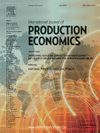 Managing disaster supply chains has much in common with managing supply chain disruptions, and a disruption may not differ much from a disaster in both scope and scale. What are the key supply chain factors for improving disaster supply chain management? The International Journal of Production Economics is perhaps not the first journal you would look up in order to answer that question. Nonetheless, their latest special issue features no less than 13 articles on this particular subject, bringing together an interdisciplinary group of scholars with a keen interest in the effective functioning of supply chains in the face of human disaster. As such ,this issue is an excellent introduction to an emerging field: the study of disaster supply chains. Some of the articles which have already been presented on this blog, and many more are to come.
Managing disaster supply chains has much in common with managing supply chain disruptions, and a disruption may not differ much from a disaster in both scope and scale. What are the key supply chain factors for improving disaster supply chain management? The International Journal of Production Economics is perhaps not the first journal you would look up in order to answer that question. Nonetheless, their latest special issue features no less than 13 articles on this particular subject, bringing together an interdisciplinary group of scholars with a keen interest in the effective functioning of supply chains in the face of human disaster. As such ,this issue is an excellent introduction to an emerging field: the study of disaster supply chains. Some of the articles which have already been presented on this blog, and many more are to come.
Do we really need to study disaster supply chains?
The timely delivery of critical goods has always been a crucial element of an effective disaster response, but an effective disaster supply chain is hard to create and maintain, and in their efforts to improve humanitarian supply chains, practitioners have enjoyed only limited help from academics. However, the challenges of disaster supply chain management are rapidly gaining attention in both practitioner and academic circles, and here is a growing number of disaster and crisis management students, but these scholars have paid little or no attention to supply chain issues. The scholars who study supply chains have paid little attention to the special challenges that disaster and crisis pose. This special issue attempts to bring these two worlds together, and as far as I am concerned, they have done an excellent job at at it.
Well worth reading
Here is a rundown of the 13 articles, with links to the publisher’s website, or to my own review.
Resilient supply chains for extreme situations: Outlining a new field of study
In this introductory article, the editors of this issue, Arjen Boin, Peter Kelle, and D. Clay Whybark sketch the contours of this new field. We begin with a brief overview of crisis and disaster management studies, which helps us understand the special challenges that these adverse events pose to supply chain managers.
All the best laid plans…conditions impeding proper emergency response
Céline Thévenaz and Sandra L. Resodihardjo kick the special issue off with an overview of “disaster barriers”—the political-administrative factors that make it hard to organize an effective response. Drawing from a rich body of empirical and theoretical research literature, they check their findings against two recent disaster cases (the 2004 Asian tsunami and Hurricane Katrina).
Coordination in humanitarian relief chains: Practices, challenges and opportunities
Burcu Balcik, Benita M. Beamon, Caroline C. Krejci, Kyle M. Muramatsu, and Magaly Ramirez discuss one of the most pertinent challenges: the coordination of actors in providing humanitarian relief. They review the literature and describe current practices. Intriguingly, they explore what can be learned from general supply chain coordination mechanisms in order to enhance the coordinative capacity of disaster supply chains.
The application of “swift trust” to humanitarian logistics
Peter Tatham and Gyöngyi Kovács consider an important factor in effective coordination: they examine how “swift trust” forms in hastily formed networks. Where trust is prominent, coordination becomes a matter of course. The authors explore under what conditions “swift trust” arises and what can be done to enhance its emergence.
Private goods and services contracts: Increased emergency response capacity or increased vulnerability?
M. Jude Egan addresses one of the most frustrating problems in building disaster supply chains: the legal necessities for securing (and relying on) key contributions of private firms. In his legal analysis, he investigates why seemingly logical and functional collaborations do nevertheless fail when they are needed most. This appears to be quite the opposite of this article on community resilience through private-public-partnerships.
Implications of organizational culture for supply chain disruption and restoration
Rachel A. Dowty and William A. Wallace offer a theoretical perspective for understanding supply chain failures. They build on two painful sagas. One is of an ice truck driving through the southern region of the US unsuccessfully trying to deliver to the victims of Hurricane Katrina. The other is of the failure on the part of the World Food Program delivering maize in South Africa. They “retool” cultural theory to help us understand how these failures could have happened.
Inventory decisions for emergency supplies based on hurricane count predictions
Selda Taskin and Emmett J. Lodree Jr. address the inventory control problem that is often encountered during hurricane preparation: what and how much to buy if you do not even know if the hurricane will hit.
Stochastic optimization of medical supply location and distribution in disaster management
Huseyin Onur Mete and Zelda B. Zabinsky develop a stochastic approach for the storage and distribution problem of medical supplies. Both contributions mark hopeful progress in the use of theory to enhance disaster preparedness.
An analysis of the Cyclone Larry emergency relief chain: Some key success factors
Richard Oloruntoba studies the Australian response to Cyclone Larry. He pays specific attention to the role of the Australian military, which proved a key to the successful response.
![]() The Yogyakarta earthquake: Humanitarian relief through IFRC’s decentralized supply chain
The Yogyakarta earthquake: Humanitarian relief through IFRC’s decentralized supply chain
Aline Gatignon, Luk N. Van Wassenhove and Aurélie Charles provide an in-depth study of the International Federation of Red Cross and Red Crescent Societies (IFRC) response to the Yogyakarta earthquake. This contribution documents the history of IFRC’s development of a decentralized disaster supply chain approach and explains why it worked so much better than a centralized approach.
Waffle House Restaurants hurricane response: A case study
Özlem Ergun, Jessica L. Heier Stamm, Pinar Keskinocak and Julie L. Swann highlight the performance of the Waffle House chain in the southern US states. Through intricate preparation, this restaurant chain manages to have its kitchens up and running within hours after a hurricane hits. The authors probe the organizational practices that allow for this effective response.
![]() Assessing the vulnerability of supply chains using graph theory
Assessing the vulnerability of supply chains using graph theory
Stephan M. Wagner and Nikrouz Neshat offer a new method to assess the vulnerability of supply chains.
Measuring the efficacy of inventory with a dynamic input–output model
Kash Barker and Joost R. Santos describe a model for assessing productivity degradations due to disasters. More specifically, the model helps to assess how different risk management approaches for inventories will affect the resilience of disrupted interdependent systems
Conclusion
So far, I’ve only read a few of the articles, but they have not let me down. While disaster management can learn a lot from supply chain management, so can supply chain management learn a lot from disaster management.












